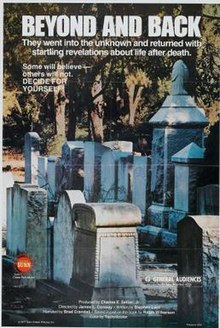Beyond and Back
| Beyond and Back | |
|---|---|

Theatrical release poster
|
|
| Directed by | James L. Conway |
| Produced by | Charles E. Sellier Jr. |
| Written by | Stephen Lord Ralph Wilkerson |
| Starring |
Brad Crandall Vern Adix Linda Bishop |
| Music by | Bob Summers |
| Cinematography | Henning Schellerup |
| Edited by | Kent Schafer |
| Distributed by | Sunn Classic Pictures |
|
Release date
|
1978 |
|
Running time
|
95 minutes |
| Country | United States |
| Language | English |
| Box office | $23,784,000 |
Beyond And Back is a 1978 documentary and "death-sploitation flick" released by Sunn Classic Pictures that deals with the subject of near death experiences.
Beyond And Back was produced by Sunn Classic Pictures, a Utah-based independent film company that specialized in releasing low-budget message movies to non-urban audiences. Along with such features as In Search of Noah's Ark (1976) and In Search of Historic Jesus (1979), the film was one of a series of releases from the company that attempted to present convincing scientific evidence for Christian theology.
Based in part on a book by evangelist Ralph Wilkerson, the idea for Beyond And Back was suggested to Sunn Pictures by a freelance writer who submitted a treatment for the film after reading about the film studio in Writer's Digest. The film's screenwriter, Stephen Lord, was a respected television screenwriter, having written scripts for such notable sci-fi/horror programs as The Outer Limits and Kolchak: The Night Stalker. Directing chores went to James L. Conway, who had helmed Sunn's speculative fiction vehicle The Lincoln Conspiracy the previous year. The movie was filmed by cinematographer Henning Schellerup, a veteran of late '60s and early '70s porn films such as Come One, Come All (1970) and Heterosexualis (1973).
Since Beyond And Back never received a traditional wide release, it was able to largely avoid scrutiny from the national media. Sunn Classic Pictures mostly screened its films in smaller towns and non-urban areas. It was also popular at drive-in movie theaters. This approach "avoided the audiences and the critical media in Los Angeles and New York... if the film failed in any single market, negative word of mouth did not spread to the next locale."
...
Wikipedia
